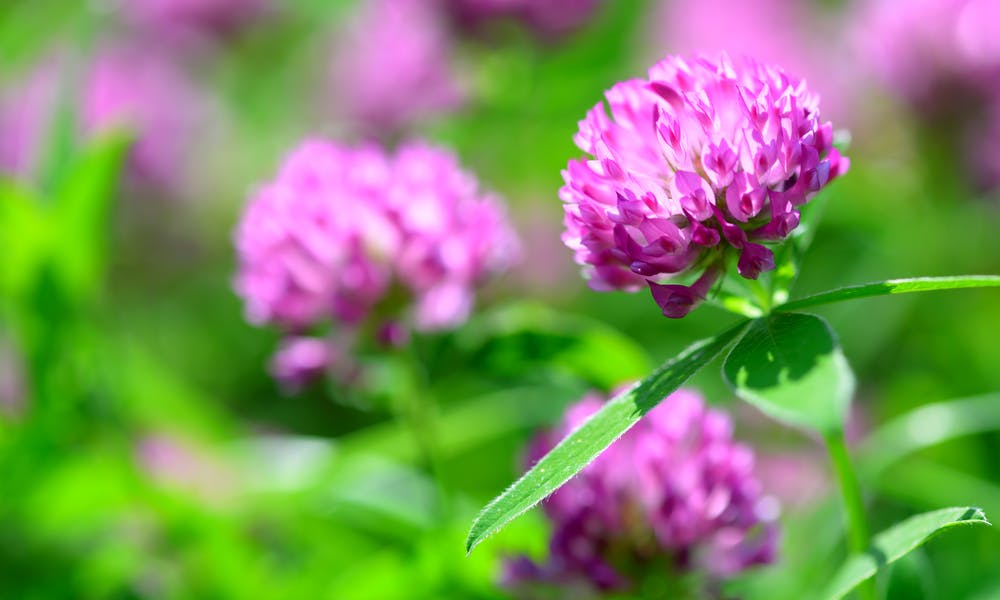MENU
The Clover Flower: Small and Mighty

The red clover, commonly known as Trifolium pratense, is a perennial plant belonging to the Fabaceae family (Leguminosae or Papilionaceae). Trifolium pratense is a native plant to Europe and distributed in many regions. It lives in the meadows, at the edges of the rivers, in the forest, as well as the mountains.
It occurs naturally throughout Europe, Asia, and North Africa. It is also introduced on other continents, cultivated for fodder. In terms of cultivation, the clover is used for soil improvement, as well as to foster biodiversity.
Today, in this article, we are going to shed light on the clover flower and its uses for healing properties. We will also learn the following:
- Description
- Species and varieties
- Cultivation
- Care
- Symbolism
- Health benefits
Description
Trifolium pratense is a branched, erect plant. The leaves are composed of three to four elliptical leaflets that are slightly hairy. The blade is dark green, usually marked with a lighter V. The clover is a short-lived perennial (2 to 3 years).
The flowers generally bloom from May to September and grow from July to October. The small papilionaceous flowers gather in a dense spike. The flowers are pink, purplish, reddish, or even sometimes white to yellowish. The clover varies into many species and subspecies. Moreover, cultivated triploid forms do not seed.
The clover plant is a biennial. Flowering occurs in the second year. In the first year, it can produce an abundant amount of leaves that you can use as a “mineralizing” herbal tea.
The plant is indeed very rich in minerals and contains calcium, magnesium, phosphorus, and potassium.
Species and Varieties
White clover and crimson clover are among the most widely used green fertilizer for their ability to fix nitrogen from the air. These legumes are part of the Fabaceae family.
The crimson clover is biennial. It would be best if you sowed it at the end of summer before the cold winter. It grows in erect tufts 20 to 50 cm high, blooms in spring, then produces seeds and dies. The crimson clover can also be cultivated in beds to take advantage of its beautiful flowering.
The white clover is a perennial. You can sow it either in early spring or in autumn without fear of the cold. The plant is rustic. Also, it is sensitive to drought and grows best in soils that remain cool.
Cultivation
Trifolium pratense appreciates fairly heavy soils, around neutral, whether rich or poor. Clover tolerates cold and wet winters and springs better than other species. Indeed, it can suffer from drought in summer, but the plant needs the sun to grow and has slow germination.
It is sown in late summer or spring for 2 to 3 years. It does not tolerate transplanting, but hasty sowing can be done in individual pots, and the plant can be placed in the ground without disturbing its roots.
The plant grows very well in pots and on a balcony. The flowers can be gathered starting the second year. Clover tends to repel other invasive and unwanted species, to, which make it a good choice for your garden.
The clover can be grown in the garden, in flower beds, in a flowery meadow, or around a vegetable patch. It can be decorative and useful for the soil and the local fauna.
Care
The clover enjoys soil that remains relatively cool. Remember to water them regularly during the summer and even more if you cultivate them in pots. In this case, and during the growth period, you can water once a week. But in winter, when the plant is dormant, sharply reduce watering to prevent the bulbs, tubers, or rhizomes from rotting.
The clover appreciates fertile and humus soils, and we advise you to enrich the soil by providing them with compost. If you are growing clover in pots, add liquid fertilizer about once a month when the plant is growing, especially in spring and summer.
After flowering, leave the leaves in place as they allow the bulbs to store energy before going dormant.
Symbolism
Clovers are herbaceous plants characterized by their leaves composed of three leaflets.
It is also a universal symbol to represent Ireland. Tradition dictates that Saint Patrick, the patron saint of the island, used the leaf of the clover to illustrate the mystery of the Trinity.
This illustration spread throughout Ireland, and the clover was very quickly associated with Saint Patrick, then with the whole of Ireland.
The four-leaf clover has become a symbol of luck and is used as an amulet to bring good luck. The flower is also one of the symbols of the car manufacturer Alfa Romeo.
Health Benefits
Red clover is a perennial herb that has long been used in traditional Chinese and Russian medicine for its sedative, diuretic, and antitussive properties. The flower has depurative, choleretic, and antispasmodic properties and to relieve external skin infections.
Red clover treats respiratory diseases. Additionally, it soothes bronchial spasms, coughs, and hoarseness. These therapeutic properties are mainly due to its abundance in isoflavones, which act as phytoestrogens.
Most traditional uses of the plant have fallen into disuse, but herbalists still recommend its use in herbal medicine. The plant is also part of the British Pharmacopoeia.
The red clover has a robust anti-cancer potential. Due to its antioxidant action, red clover is an ideal plant to integrate into our daily diet to prevent and fight against certain cancers.
Multiple studies show that red clover can help prevent and treat heart disease. Some scientific studies have found that it lowers high cholesterol levels. Interestingly, the isoflavones found in clover are an effective remedy for increasing good cholesterol in both pre- and post-menopausal women. Another study published in the journal Experimental and Therapeutic Medicine has shown that a red clover extract can help prevent and treat diabetes.

